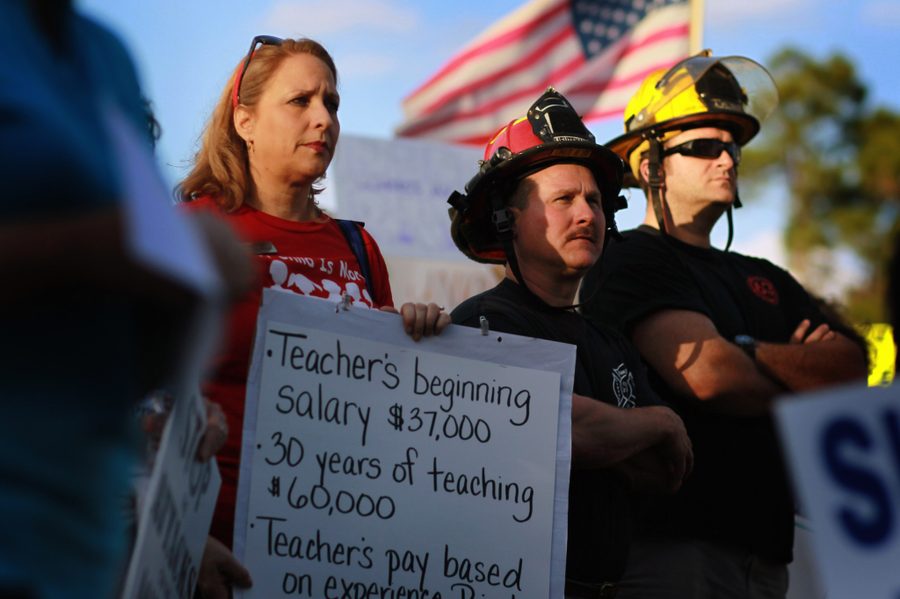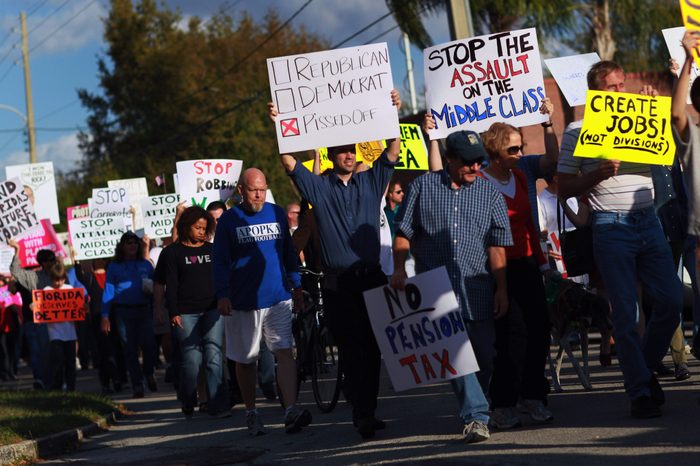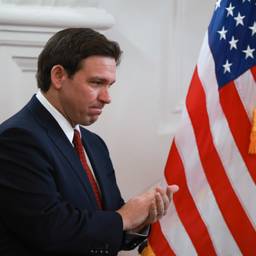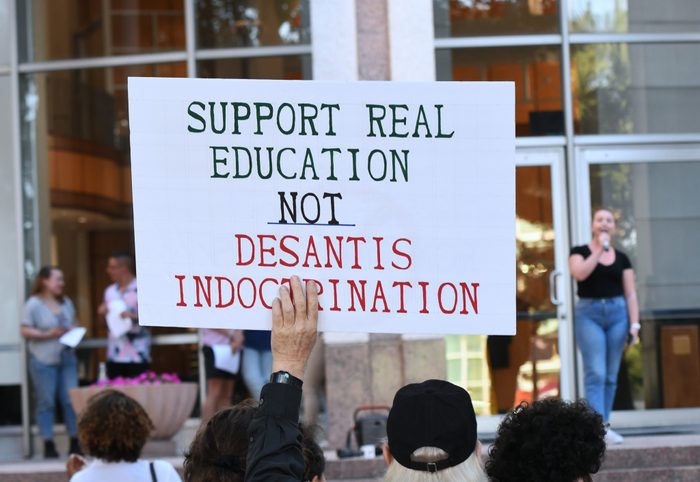More than 50,000 Florida workers have lost their union membership in the advent of S.B. 256.

TALLAHASSEE, FLORIDA — Early one February morning, Chris Pagel, a retired U.S. Army combat engineer and physical education teacher, begins his three-and-a-half hour drive from Nassau County to the Florida Capitol in Tallahassee. He’s opposing a bill designed to build on S.B. 256 — an anti-union law passed last year that has, so far, already caused more than 50,000 public employees to lose their union representation.
Later, standing in front of lawmakers, he questions why he bothered making the drive at all. “I’ve been here before,” he says during public testimony. “The Republicans have already made up their mind. Democrats fight it.”
More than a decade in the making, S.B. 256 essentially requires unions to have a lot of dues-paying members while simultaneously making it harder for them to do so. While the law bans public sector unions from deducting dues directly from members’ paychecks, it also requires at least 60% of a bargaining unit to pay dues or risk losing their union status.
Shortly after signing the bill, Florida Gov. Ron DeSantis framed it in a statement as an effort to “reign in out-of-control unions” that he said take money away from teachers and misuse government funds for political aims. In the same announcement, he specifically mentioned teachers unions, many of which were already required to maintain at least 50% membership under a law approved by then Gov. Rick Scott in 2018.
Pagel is a registered Republican and president of the Nassau Teachers’ Association. When Florida lawmakers and DeSantis approved the legislation in 2023, teachers unions like his — representing a large share of the state’s unionized public sector — declared they were being targeted.

Union supporters and teachers protest austerity in Orlando, Florida, on March 8, 2011, at the beginning of Florida's legislative session.PHOTO BY JOE RAEDLE VIA GETTY IMAGES
Most other public sector unions — which hadn’t previously been subject to any membership threshold—became collateral damage. While some teachers unions lost members due to the payroll deduction ban, not one of the 48 decertified bargaining units represented teachers. Most were decertified due to low membership and represented state and municipal employees (such as utilities and code enforcement workers and non-instructional staff in public schools and universities).
Under the new law, bargaining units reporting low membership can petition for an election to keep their union intact. This must be done within a month of submitting mandatory annual paperwork to the state confirming membership numbers and requires gathering signed cards from at least 30% of employees in support. Then, a simple majority must vote to recertify. If the union doesn’t file a petition at all, they’re decertified. The latter has been the case for all units dissolved so far.
“We have not and we do not intend on losing any local unions in the Florida Education Association."
Andrew Spar, president of the statewide teachers union, is adamant that educators won’t see the same fate. “We have not and we do not intend on losing any local unions in the Florida Education Association,” says Spar.
Unions have entered survival mode, mobilizing to recruit and retain members. Several, including the Florida Education Association (FEA), have sued the state over the law.
Erik Hagen, a 31-year-old elementary school music teacher in Hillsborough County, says transitioning members to a new dues payment system has been a “huge undertaking,” especially for older teachers. His union rose to the challenge. Nonetheless, he describes the entire situation as a “nightmare.”
“I shouldn’t be spending all of this time walking around, just trying to get people who were members back to being members."
“I shouldn’t be spending all of this time walking around, just trying to get people who were members back to being members,” says Hagen. “I should be spending my time supporting my teachers, building personal connections.”
The impact, he argued, extends beyond schools and the union hall. “Any attack against teachers and labor movements in Florida damages society as a whole,” he adds.
There’s one unintended consequence of the law that troubled its Republican sponsors and DeSantis: its impact on police and firefighter unions. S.B. 256 aimed to exempt these unions from most of the new regulations, including the membership threshold and payroll dues deduction ban. The bill’s sponsors argued that first responders belong to a special category of workers who deserve to be treated differently than others in the public sector.

The Right Has a New Playbook to Crush Unions and Enshrine Corporate Power
The American Legislative Exchange Council is pushing a spate of anti-worker bills in states across the country—the latest in the group's onslaught on collective bargaining rights.
JULIANA BROAD
But then last summer the state agency in charge of rulemaking determined that some police and firefighter unions must follow the new rules like everyone else because some of their units also contain civilian employees who weren’t clearly carved out of the bill.
Emails I obtained through a public records request for Orlando Weekly show police and firefighter unions consequently lobbied the Republican sponsors of S.B. 256 to exempt all their members. So did lobbyists for out-of-state conservative think tanks, like the Freedom Foundation and the Mackinac Center for Public Policy. Both have a history of advocating for similar anti-union policies in other states.
In January 2024, a so-called glitch bill delivering such carve-outs — and new, onerous reporting requirements for nonexempt unions — was born. Florida Rep. Dean Black, one of the GOP sponsors, described the glitch bill to me as a follow-up to last year’s legislation. Sen. Blaise Ingoglia, the bill’s sponsor in the Senate, described it during a public hearing as an effort to clarify the bill’s original intent.

Students walk out of school to oppose Florida education policies outside Orlando City Hall on April 21, 2023.PHOTO BY PAUL HENNESSY/ANADOLU AGENCY VIA GETTY IMAGES
Pagel, the teacher and union president, leans over the speaker podium with purpose while delivering public testimony on the glitch bill.
“As a Republican, I can tell you, I am embarrassed and ashamed that we keep on voting yes when your constituents are telling you no,” Pagel says, staring down the panel of mostly Republican lawmakers. “Please get a backbone and vote ‘No.’”
Despite Democratic opposition, the glitch bill passed the GOP-dominated legislature, with seven Republicans dissenting.
Many units are anxiously awaiting recertification elections, with union leaders hopeful that workers will vote to preserve their unions.
The future of Florida’s unionized public sector remains unclear. But some on the frontlines remain cautiously optimistic. Many units are anxiously awaiting recertification elections, with union leaders hopeful that workers will vote to preserve their unions. Twelve of them, including two teachers unions, already have. But if dues-paying membership falls below 60%, they’ll have to repeat the process next year.
None of this is occurring in a vacuum. At the same time Florida’s unions are fighting to survive the new rules, they’re also fighting for better wages and against book bans and industry-backed rollbacks to the state’s child labor laws.
Johanna “Hanna” Folland, a high school history teacher in South Florida, puts it bluntly: “We need solidarity and we need help.”
Folland is a member of the United Teachers of Dade (UTD), a union targeted by the Freedom Foundation for decertification. UTD is one of the largest teachers unions in the country, and its president, Karla Hernandez-Matz, ran on a Democratic ticket for lieutenant governor of Florida in 2022. She and her running mate, Charlie Crist, were endorsed by teachers unions and lost to DeSantis. Badly.
“Teachers will stick together” and fight, Folland assures me. We’re sitting at a table inside Chicago’s Hyatt Regency O’Hare hotel on the final day of the 2024 Labor Notes Conference. We’re both exhausted but simultaneously heartened and inspired by the dwindling motley crew of union activists around us. The battle in Florida, she admitted, is one she expects teachers will continue to fight “probably every year for the foreseeable future.”
MCKENNA SCHUELER is a staff reporter for Orlando Weekly in Florida, where she covers labor issues, local news and politics. Her work has also appeared in Strikewave, Facing South, Protean Mag and Creative Loafing Tampa Bay.







